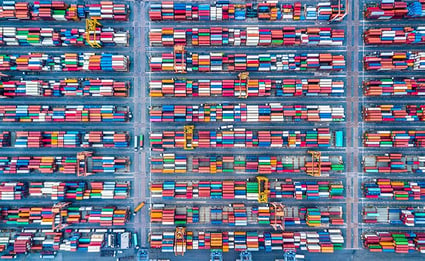The 4 Best Qualities in a TMS for the Digital Supply Chain
Keith LaBotz - September 08, 2022

Choosing the right Transportation Management Software (TMS) could mean the difference between success and failure for your company in the next few years.
The digital transformation of transportation will significantly impact supply chains, and a company’s TMS solution must evolve with the changes. Most TMS solutions were designed around a supply chain model invented over 30 years ago, and they’ll become a liability as digitalization progresses.
Using a TMS not designed for a digital supply chain is using the wrong tool, and many companies will not realize that this is the source of their problem. Transportation will become increasingly more challenging as once-reliable TMS solutions grow less effective.
The consequences of a failing transportation process can be severe, extending beyond the shipping operation. Transportation is the core of a supply chain; it's the physical link in the chain delivering the goods. Shipping problems will impact every business enterprise area, so it’s crucial to resolve them quickly.
The solution? Use the correct tool; a TMS designed for the digital supply chain. That’s simple enough, but determining whether or not a TMS meets this requirement may not be so obvious.
This article gives you four qualities to look for in a TMS solution to help you confirm it will meet future transportation demands.
A Digital Supply Chain Needs a Digital TMS
Supply chain digitization will advance, and so must your TMS solution. There’s no choice in this matter because a supply chain wildfire will burn up any company that’s not agile enough to move. Agility requires a digital business process, and transportation is at its core.
OK, your CFO isn’t going to buy a poetic allusion to fire, so let’s examine a couple of use cases for TMS agility.
Restructuring Supply Chains. Consider an electronic manufacturer relocating production from Asia closer to home to minimize disruptions, logistics costs, and carbon emissions. The gains from restructuring the supply chain are substantial, and significant changes in transportation arrangements are incumbent on such a change.
Supply chain restructuring is a process; it’s not a one-time move, and it can take some companies years to complete the migration. Success depends on containing transportation costs and risks, and it may require a lot of trial and error along the way.
Supply chains may also become more fluid in the future as digitalization streamlines the onboarding of new partners. The ability to change suppliers, production, and distribution sites at will without disruption is a powerful strategy that introduces fault tolerance.
Given these requirements, a TMS must be capable of quickly accommodating new routing rules, transportation providers, suppliers, modes of transportation, and customs requirements. These changes are complex, risky, and costly without a digital TMS.
Increased Control. Supply chain volatility does not wait on third parties to prioritize a company’s needs. 3PLs provide economy of scale, but there is no control over your priority. Getting top priority was far less of a concern in the stable supply chain over the past 30 years, but supply chains are becoming more dynamic and volatile.
Transportation is strategic, so responses must be quick to prevent cascading disruptions. A digital TMS with end-to-end visibility, predictive analytics, and AI-assisted decisions is essential. Companies are swapping out 3PLs for more capable TMS solutions, as highlighted in Gartner’s 2021 Logistics and Contract Manufacturing Outsourcing survey:
-
70% of respondents planned to bring back at least one portion of outsourced logistics services.
-
Managed transportation services were the top choice, with more than 20% planning to address these with an enterprise TMS solution.
An Agile Supply Chain Needs an Agile TMS
A recent article from McKinsey about manufacturers taking a broader view of the supply chain notes:
“Delivering products at the right time, the right quality, and at the best cost is no longer enough. Organizations now need networks with the resilience to tolerate shocks and the agility to respond to demanding customers and fast-changing markets.”
-
A TMS must be flexible in its design to enable an agile transportation process that ensures the lowest cost and risk under all conditions.
-
Flexibility includes user customization and open systems integration that supports any process and workflow.
-
A TMS offering API access is ideally suited for an agile process, where functions can be made accessible for internal and external systems.
As the supply chain digitization increases, so will operational agility, and the difference will grow more pronounced between companies. This agility gap will drive businesses to partner with others of comparable capabilities. The most agile shippers will find the most success partnering with the most agile transportation providers and vice-versa.
Less agile shippers and carriers will suffer each other’s inflexibility and efficiencies, giving an advantage to those using more agile TMS solutions.
A TMS Should Continuously Improve
Look for a TMS that increases value through continuous updates with new functionality. The number of TMS solutions has grown along with its capabilities, so the competition is healthy. Shippers have more opportunities to find and try out the “best-fit solution" with affordable cloud-based subscriptions.
-
Continuous Enhancements. Ongoing improvements to software and services translate to more process improvements for users. A good TMS partner engaged with customers will constantly improve their offering.
-
Software Maturity. Applications developed by a vendor that has insight into transportation solutions will have a more mature, richer feature set and data model. You do not want your company to become a developer’s sandbox!
-
Flexibility. User configurable features, parameters, and systems interfaces are crucial for making rapid, inexpensive, low-risk changes as requirements change.
-
SaaS. Cloud-based solutions eliminate upfront and ongoing maintenance costs. Implementation is also accelerated. This allows users to focus on transportation improvements, resulting in a higher ROI and greater agility.
TMS Must Benefit Transportation Carriers
A good TMS makes it easier for carriers to work with a shipper, creating a stronger, more profitable relationship for both parties.
Transportation capacity challenges reminded shippers of the value of establishing strong carrier relationships. Being a “shipper of choice” ensures priority when capacity is tight. Appropriately used, TMS is a strategic tool for strengthening partnerships with transportation providers.
Along those same lines, digitization opens the door to systems integration, and that’s more conducive to long-term relationships. Shippers and carriers that conduct business digitally through a TMS will function as partners.
Conclusion
Choosing the right TMS may be the most important your company makes, so choose wisely. Hopefully, the four qualities outlined in this article will help you do that.
flexis AG offers a TMS solution and services that meets the criteria discussed in this article. We would be happy to discuss your specific needs and how our solution may benefit your company.INTERESTED IN MORE INFORMATION?
LATEST POSTS
- Understand Circular Economy in The Manufacturing Industry
- How Can Industry 4.0 IT Integration Be Achieved Smoothly?
- The Significance of Order Sequencing in Discrete Manufacturing
- How to improve your Supply Chain Management: The Power of Control Towers
- Optimizing Human Resource Scheduling in Manufacturing: A Technological Approach



